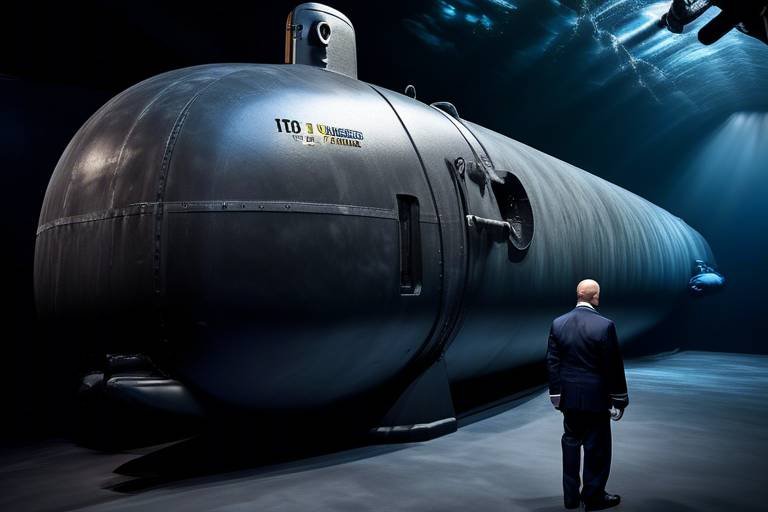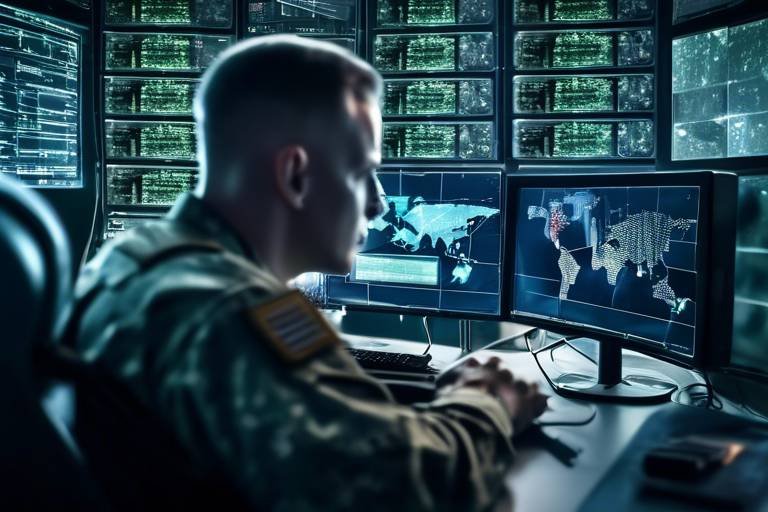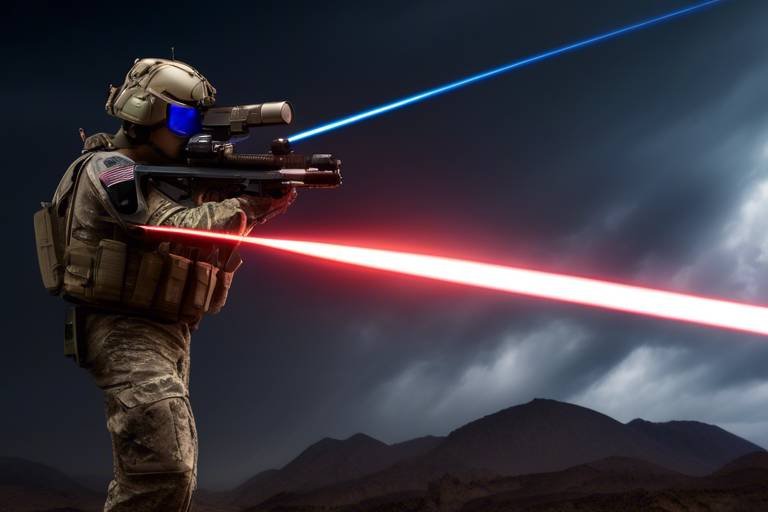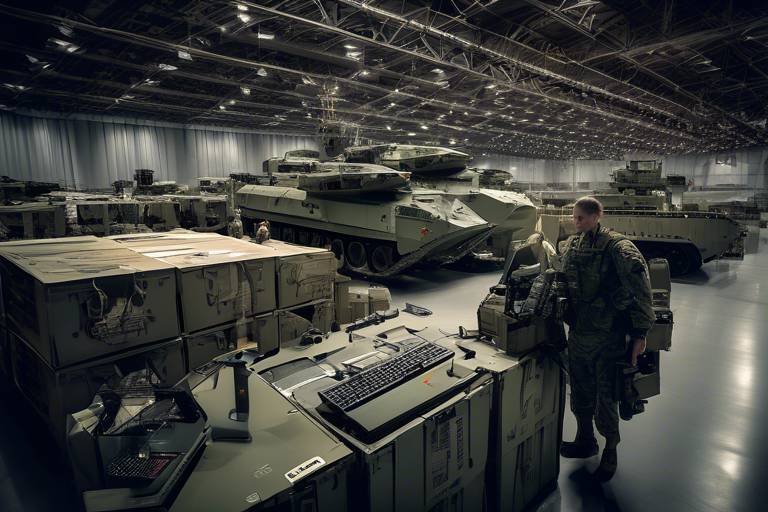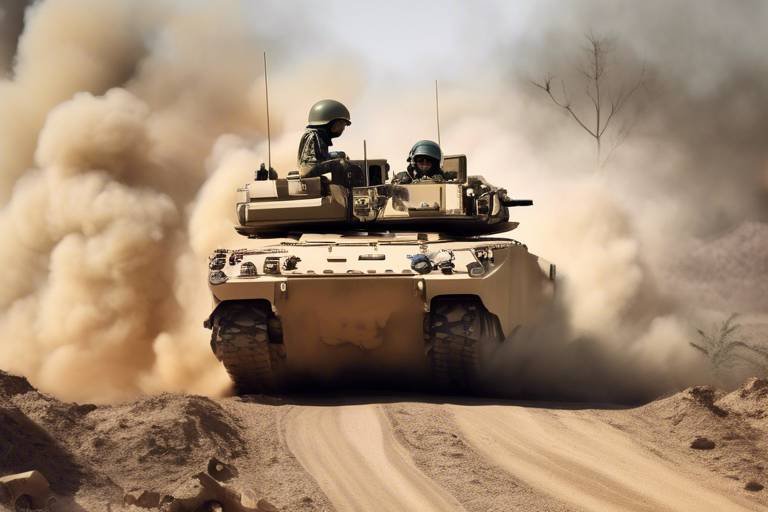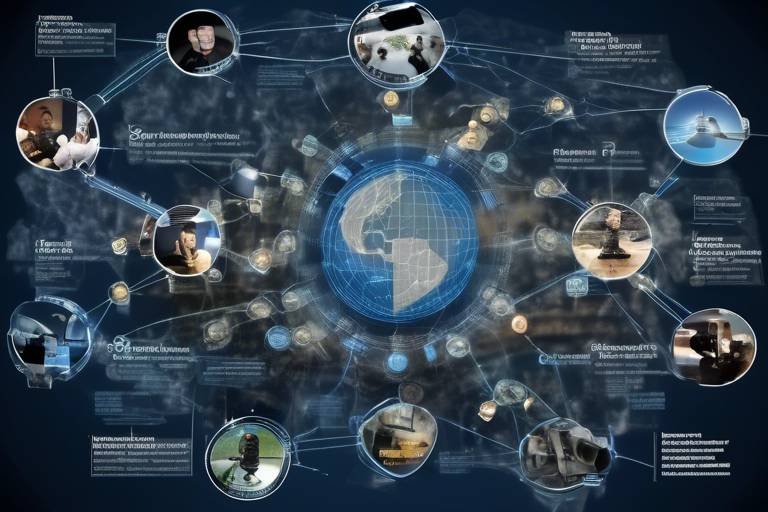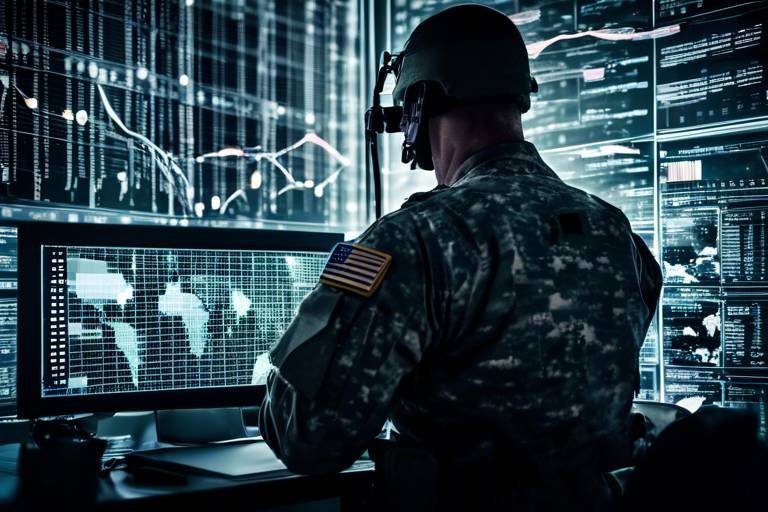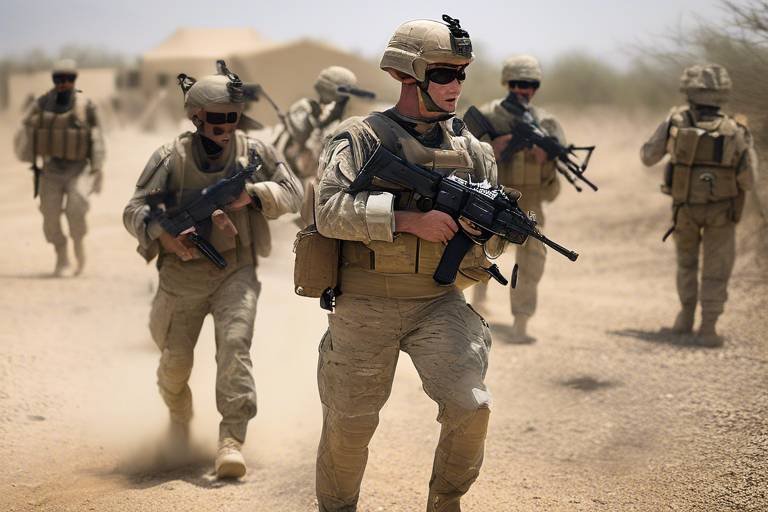Evaluating the Role of Advanced Sensors in Combat Operations
In the ever-evolving landscape of modern warfare, the significance of advanced sensors cannot be overstated. These technologies have become the backbone of military operations, providing critical data that enhances decision-making and operational effectiveness. Imagine being in a high-stakes game of chess, where every move is crucial, and knowing your opponent's strategy can mean the difference between victory and defeat. This is precisely what advanced sensors offer to military commanders on the battlefield. They enable real-time situational awareness, allowing for swift and informed tactical decisions that can change the tide of combat.
Advanced sensors encompass a diverse array of technologies designed to collect, process, and disseminate information in combat environments. From unmanned aerial vehicles (UAVs) to ground-based detection systems, these sensors are integral to gathering intelligence, monitoring enemy movements, and ensuring the safety of troops. As we delve deeper into the applications and benefits of these systems, it becomes evident that their role is not only about enhancing military capabilities but also about redefining the very nature of combat operations.
As we explore the applications of advanced sensors in combat scenarios, we will uncover how they facilitate everything from reconnaissance missions to target acquisition. The battlefield is a complex environment, often characterized by chaos and uncertainty. In this context, having access to reliable and timely information is paramount. Advanced sensors act as the eyes and ears of military forces, providing a comprehensive view of the battlefield that was previously unimaginable.
However, the integration of these technologies is not without its challenges. Issues such as technological vulnerabilities and the need for robust training programs must be addressed to maximize the effectiveness of advanced sensors. As we progress through this article, we will examine both the remarkable benefits and the potential drawbacks of these systems, ultimately highlighting their critical role in shaping the future of military operations.
Advanced sensors are not just a single type of technology; they represent a broad spectrum of devices and systems that are crucial for military operations. These sensors can be classified into several categories, each serving a unique purpose in combat scenarios. For instance, optical sensors are used for visual surveillance, while radar systems can detect moving objects regardless of visibility conditions. Additionally, infrared sensors are invaluable for identifying heat signatures, making them essential for night operations.
The functionalities of these sensors vary widely, but their ultimate goal is the same: to provide actionable intelligence that enhances military effectiveness. In the age of information warfare, the ability to collect and analyze data swiftly can mean the difference between life and death. As we delve further into the applications of these sensors, we will explore how they are revolutionizing reconnaissance, surveillance, and target acquisition on the battlefield.
Advanced sensors play a crucial role in various combat scenarios, from reconnaissance to target acquisition. Their applications are diverse and multifaceted, providing military forces with the tools they need to navigate complex environments. One of the most significant areas where these sensors shine is in reconnaissance and surveillance. Utilizing advanced sensors for these purposes offers real-time intelligence, which is vital for understanding enemy movements and positions.
Imagine a soldier on the ground, equipped with the latest sensor technology that allows them to see beyond the horizon. This is what advanced sensors enable in terms of reconnaissance and surveillance. By gathering critical information about enemy activities, these technologies empower commanders to make informed decisions that can significantly alter the outcome of a mission.
Drones equipped with advanced sensors are revolutionizing reconnaissance missions. These unmanned aerial vehicles provide a bird's-eye view of the battlefield, allowing for enhanced aerial surveillance capabilities. With the ability to cover vast areas quickly and efficiently, drones have become invaluable assets in modern combat operations, providing tactical advantages that were previously unattainable.
In addition to aerial reconnaissance, ground-based sensor systems also contribute significantly to battlefield intelligence. These systems are designed to detect enemy activity and secure perimeters, ensuring that troops can operate with a higher level of safety and confidence. The integration of ground-based sensors with aerial technologies creates a comprehensive network of intelligence that enhances situational awareness across the board.
When it comes to target acquisition and engagement, advanced sensors are game-changers. They improve the precision with which military forces can identify and neutralize threats. Imagine having a tool that not only identifies a target but also provides real-time data on its movement, allowing for a calculated response. This capability is crucial in modern warfare, where the margin for error is razor-thin.
The integration of advanced sensors into military operations offers numerous advantages. One of the most significant benefits is improved accuracy in decision-making. With access to real-time data, commanders can make informed tactical decisions that enhance operational effectiveness. This level of situational awareness is akin to having a GPS system in an unfamiliar city; it allows military leaders to navigate the complexities of the battlefield with confidence.
Advanced sensors provide commanders with a wealth of information, significantly enhancing situational awareness. This capability leads to more informed tactical decisions, allowing military forces to anticipate enemy actions and respond proactively. The ability to visualize the battlefield in real-time is not just an advantage; it's a necessity in today's fast-paced combat environment.
With advanced sensors, military operations become more efficient. These technologies streamline processes and reduce resource expenditure during combat missions. By providing accurate data, advanced sensors help minimize waste and ensure that resources are allocated where they are needed most, ultimately leading to more successful outcomes.
Despite their advantages, advanced sensors face several challenges and limitations. Technological vulnerabilities, such as susceptibility to hacking and jamming, pose significant risks to combat operations. As we rely more on these systems, understanding and mitigating these risks becomes essential for maintaining operational integrity.
Advanced sensors can be vulnerable to cyber threats, making them susceptible to hacking and jamming. This subsection analyzes the risks associated with these vulnerabilities and their implications for combat operations. The reliance on technology means that adversaries may seek to exploit these weaknesses, necessitating ongoing investment in cybersecurity measures to protect critical systems.
Effective use of advanced sensors requires proper training. Integrating these technologies into existing military frameworks presents challenges, as personnel must be educated on their functionalities and applications. This section addresses the importance of ongoing soldier education and the need for robust training programs to ensure that military forces can maximize the benefits of advanced sensors.
- What are advanced sensors? Advanced sensors are technologies used to collect data in combat environments, enhancing situational awareness and operational effectiveness.
- How do drones contribute to military operations? Drones equipped with advanced sensors provide aerial surveillance and reconnaissance capabilities, allowing for real-time intelligence gathering.
- What are the main benefits of using advanced sensors? Key benefits include improved accuracy, enhanced decision-making, and increased operational efficiency.
- What challenges do advanced sensors face? Challenges include technological vulnerabilities, such as hacking and jamming, and the need for proper training and integration into military frameworks.

Understanding Advanced Sensors
Advanced sensors are at the forefront of modern military technology, revolutionizing the way we gather and interpret data in combat environments. These sophisticated devices are designed to collect a wide array of information, ranging from environmental conditions to enemy movements, thereby enhancing the effectiveness of military operations. Imagine being able to see through walls or detect a heartbeat from hundreds of meters away; that's the kind of capability advanced sensors bring to the battlefield.
There are several types of advanced sensors, each with unique functionalities that cater to different aspects of military operations. Some of the most notable include:
- Optical Sensors: These sensors capture visual information, often used in reconnaissance missions to provide real-time imagery of the battlefield.
- Infrared Sensors: These detect heat signatures, making them invaluable for identifying enemy troops or vehicles, even in low visibility conditions.
- Acoustic Sensors: Utilizing sound waves, these sensors can detect movements or activities from a distance, providing crucial auditory intelligence.
- Radar Systems: Emitting radio waves, radar can identify and track objects, including aircraft and missiles, ensuring comprehensive situational awareness.
Each type of sensor plays a critical role in enhancing the military's ability to make informed decisions swiftly. For instance, optical sensors provide clear visuals that can be analyzed in real-time, while infrared sensors can pinpoint hidden threats that would otherwise go unnoticed. The integration of these technologies into military operations has transformed traditional combat strategies, allowing forces to operate with a level of precision and awareness that was previously unimaginable.
Moreover, advanced sensors are not just limited to a single platform; they can be deployed across various systems, including drones, ground vehicles, and even wearable technology for soldiers. This interconnectedness ensures that data from multiple sources can be synthesized, providing a comprehensive picture of the battlefield. In essence, advanced sensors act as the eyes and ears of military forces, enabling them to anticipate enemy actions and respond effectively.
However, the implementation of advanced sensors is not without its challenges. As technology evolves, so do the tactics employed by adversaries. The military must continuously adapt to counteract threats such as electronic warfare, which can disrupt sensor functionality. This ongoing arms race between sensor technology and countermeasures highlights the importance of innovation and robust training for personnel operating these advanced systems.
In conclusion, understanding advanced sensors is crucial for appreciating their impact on modern combat operations. They are not merely tools; they are game-changers that enhance situational awareness, improve decision-making, and ultimately save lives on the battlefield. As we continue to explore the applications of these technologies, it becomes clear that their role in military effectiveness is only set to grow.

Applications in Combat Scenarios
Advanced sensors have become the backbone of modern military operations, significantly enhancing the effectiveness of combat scenarios. From reconnaissance to target acquisition, these sensors are pivotal in providing real-time data that shapes tactical decisions on the battlefield. Imagine being able to see through walls or detect movement in dense forests; that's the power of advanced sensor technology. Their applications are vast and varied, and they play a crucial role in ensuring that military forces can operate with a level of precision and awareness that was once unimaginable.
One of the most notable applications of advanced sensors is in the realm of reconnaissance and surveillance. These technologies allow military units to gather critical intelligence about enemy positions and movements without exposing themselves to danger. For instance, drones equipped with high-resolution cameras and thermal imaging sensors can fly over enemy territory, providing commanders with a bird's-eye view of the battlefield. This capability not only enhances situational awareness but also enables forces to anticipate enemy actions and plan accordingly.
Utilizing advanced sensors for reconnaissance and surveillance provides real-time intelligence. This subsection discusses the importance of these technologies in gathering critical information about enemy movements and positions. The integration of drone technology has revolutionized how military forces conduct surveillance. Drones can cover vast areas quickly and efficiently, transmitting live feeds back to command centers. This immediate access to information can be the difference between success and failure in combat operations.
Drones equipped with advanced sensors are revolutionizing reconnaissance missions. They not only provide aerial views but can also be fitted with various sensors to detect different types of enemy activity. For instance, electro-optical and infrared sensors allow drones to operate effectively day or night, regardless of weather conditions. This versatility gives military forces a tactical advantage, enabling them to conduct operations with a level of stealth and precision that ground units simply cannot match.
Ground-based sensor systems also contribute significantly to battlefield intelligence. These sensors can be deployed in strategic locations to monitor and detect enemy movements. For example, motion detectors and acoustic sensors can alert troops to potential threats, allowing them to respond quickly. The effectiveness of these systems in detecting enemy activity and securing perimeters cannot be overstated. They act as an additional layer of defense, providing commanders with invaluable information that enhances their operational capabilities.
Advanced sensors improve target acquisition and engagement in combat. This subsection focuses on how these technologies assist in identifying and neutralizing threats with precision. Imagine a scenario where a soldier can identify a target from hundreds of meters away with pinpoint accuracy; that’s the reality that advanced sensors bring to the battlefield. By integrating various sensor types, military forces can achieve a comprehensive understanding of the operational environment, allowing for more effective engagement strategies.
In summary, the applications of advanced sensors in combat scenarios are transformative. They enhance reconnaissance capabilities, improve situational awareness, and facilitate precise target acquisition. As technology continues to evolve, we can expect to see even more innovative uses for these sensors, further solidifying their role as essential tools in modern warfare.
- What are advanced sensors? Advanced sensors are technologies used in military operations to collect data and provide real-time intelligence on the battlefield.
- How do drones enhance reconnaissance? Drones equipped with advanced sensors provide aerial surveillance, allowing for real-time data collection and improved situational awareness.
- What are the benefits of ground-based sensor systems? Ground-based sensor systems detect enemy activity and secure perimeters, acting as a vital layer of defense on the battlefield.
- Can advanced sensors be hacked? Yes, advanced sensors can be susceptible to hacking and jamming, which poses risks to military operations.

Reconnaissance and Surveillance
In today's fast-paced military landscape, have become critical components of operational success. With the advent of advanced sensors, military forces can now gather real-time intelligence that significantly enhances their situational awareness. Imagine being able to see the battlefield from above, pinpointing enemy positions and movements with pinpoint accuracy—this is the power that modern sensors bring to the table.
Advanced sensor technologies, such as radar systems, infrared cameras, and electro-optical devices, are revolutionizing how reconnaissance missions are conducted. These tools allow military personnel to monitor vast areas without putting themselves at risk. For instance, radar systems can detect enemy aircraft or incoming missiles long before they pose a threat, giving commanders valuable time to respond. Similarly, infrared cameras can pick up heat signatures in complete darkness, allowing for surveillance even in the dead of night.
The importance of real-time intelligence cannot be overstated. In combat scenarios, the ability to quickly assess the situation can mean the difference between victory and defeat. Advanced sensors provide a wealth of data, including:
- Enemy troop movements
- Vehicle locations
- Potential ambush sites
- Environmental conditions
This information is crucial for making informed tactical decisions. For example, if a commander knows the exact location of enemy forces, they can devise a strategy to flank them or avoid confrontation altogether. The integration of these advanced technologies into reconnaissance missions not only enhances operational effectiveness but also reduces the risk to personnel.
One fascinating development in this field is the use of drones. These unmanned aerial vehicles (UAVs) are equipped with sophisticated sensors that allow them to conduct surveillance missions without risking human lives. Drones can fly over hostile territories, capturing high-resolution images and video feeds that are relayed back to command centers in real-time. This capability enables military leaders to make swift, informed decisions based on the latest intelligence.
Moreover, ground-based sensor systems complement aerial reconnaissance by providing a different perspective on battlefield dynamics. These systems can be strategically placed to monitor key areas and alert troops to any unusual activity. For example, ground sensors can detect vibrations caused by vehicles or even footsteps, giving commanders a heads-up about potential threats. The synergy between aerial and ground-based systems creates a comprehensive surveillance network that enhances overall situational awareness.
In summary, the role of advanced sensors in reconnaissance and surveillance is transformative. They provide military forces with the critical information needed to make informed decisions, strategize effectively, and ultimately, achieve mission objectives. As technology continues to evolve, we can expect even greater advancements in sensor capabilities, further improving the effectiveness of military operations on the battlefield.
- What types of sensors are commonly used in reconnaissance? Advanced sensors include radar systems, infrared cameras, electro-optical devices, and drones.
- How do drones enhance reconnaissance missions? Drones provide real-time aerial surveillance, capturing high-resolution images and video without risking human lives.
- What are the benefits of using ground-based sensor systems? Ground-based sensors can detect vibrations and unusual activities, providing critical alerts to military personnel.
- How does real-time intelligence impact military operations? Real-time intelligence allows for informed tactical decisions, which can significantly influence the outcome of combat scenarios.

Drone Technology
In the realm of modern warfare, has emerged as a game-changer, transforming the way military operations are conducted. These unmanned aerial vehicles (UAVs) are equipped with advanced sensors that provide unparalleled situational awareness and tactical advantages. Imagine having the ability to gather intelligence from above without putting any personnel at risk; that’s the power of drones. They can fly high above the battlefield, capturing real-time data and delivering it back to commanders on the ground, ensuring that decisions are based on the most current information available.
One of the most significant benefits of drone technology is its capability for persistent surveillance. Drones can loiter over a specific area for extended periods, allowing military forces to monitor enemy movements and gather vital intelligence without detection. This capability is crucial in combat scenarios where every second counts, and having the most accurate information can mean the difference between success and failure. With high-resolution cameras and advanced imaging systems, drones can identify targets and assess situations in ways that were previously unimaginable.
Moreover, the integration of drones into military operations has led to enhanced reconnaissance missions. For instance, drones can be deployed in hostile territories to conduct surveillance without risking the lives of soldiers. They can collect data on enemy positions, movements, and even environmental conditions. The intelligence gathered can then be analyzed to formulate strategies and inform tactical decisions. This not only increases the effectiveness of military operations but also minimizes collateral damage, as precise targeting becomes more achievable.
To illustrate the capabilities of drone technology, consider the following table that highlights the different types of drones and their functionalities in combat:
| Type of Drone | Primary Function | Key Features |
|---|---|---|
| Reconnaissance Drones | Intelligence Gathering | High-resolution cameras, real-time data transmission |
| Combat Drones | Target Engagement | Armed with missiles, precision targeting systems |
| Surveillance Drones | Persistent Monitoring | Long flight times, advanced imaging technology |
Additionally, the use of drones in combat operations has sparked a new era of tactical innovation. Military strategists are now able to devise plans that leverage the unique capabilities of drones. For instance, drones can be used to create a network of intelligence that feeds information back to command centers in real-time, allowing for rapid response to emerging threats. This interconnectedness not only enhances situational awareness but also facilitates coordinated efforts among different branches of the military.
However, the rise of drone technology is not without its challenges. As these systems become more prevalent, adversaries are also developing countermeasures to disrupt their effectiveness. This ongoing cat-and-mouse game highlights the need for continuous innovation and adaptation within military strategies. Nevertheless, the potential of drone technology to revolutionize combat operations is undeniable, and as advancements continue, we can expect to see even more sophisticated applications in the future.
In summary, drone technology is reshaping the battlefield by providing critical intelligence, enhancing operational efficiency, and enabling more precise targeting. As military forces continue to embrace these advanced systems, the future of combat operations will undoubtedly be influenced by the capabilities and innovations that drones bring to the table.

Ground-Based Sensor Systems
Ground-based sensor systems are a vital component of modern military operations, providing a robust framework for gathering intelligence and enhancing battlefield awareness. These systems, often deployed in strategic locations, utilize a variety of technologies to detect, track, and analyze enemy movements. Imagine having a pair of eyes on the ground that never blinks, constantly scanning for potential threats and relaying crucial information back to commanders. This is the essence of ground-based sensors—they are the silent sentinels that bolster a military's operational capabilities.
One of the primary functions of ground-based sensor systems is to detect enemy activity. This is achieved through a combination of radar, infrared, and acoustic sensors, each playing a unique role in the surveillance process. For instance, radar systems can identify moving targets, while infrared sensors are adept at detecting heat signatures, making them particularly effective during nighttime operations. Acoustic sensors can pick up sounds from distant vehicles or troop movements, providing an additional layer of intelligence. Together, these technologies create a comprehensive picture of the battlefield, allowing military leaders to make informed decisions.
Moreover, ground-based sensor systems are critical for securing perimeters and protecting vital assets. They can be strategically placed around military installations, supply depots, or forward operating bases to create a robust defense network. When integrated with automated alert systems, these sensors can notify personnel of any unauthorized movements, enabling rapid response to potential threats. The ability to monitor vast areas without human intervention significantly enhances the safety and security of military operations.
Another key advantage of ground-based sensor systems is their flexibility and adaptability. They can be deployed in various terrains, from urban environments to rugged landscapes, and can be quickly relocated as operational needs change. This adaptability is essential in today’s dynamic combat scenarios, where the battlefield is constantly evolving. Furthermore, advancements in technology have led to the development of smaller, more efficient sensors that can be easily integrated into existing military frameworks, ensuring that forces remain agile and ready to respond to emerging threats.
| Type of Sensor | Functionality | Application |
|---|---|---|
| Radar Sensors | Detects moving targets through radio waves | Tracking enemy vehicles and aircraft |
| Infrared Sensors | Detects heat signatures | Nighttime surveillance and target identification |
| Acoustic Sensors | Detects sounds from distant movements | Monitoring troop movements and vehicle sounds |
In conclusion, ground-based sensor systems are indispensable in enhancing military effectiveness. They not only provide critical intelligence but also improve the safety of personnel and assets on the battlefield. As technology continues to evolve, the capabilities of these systems will only expand, further solidifying their role in modern combat operations.
- What are ground-based sensor systems? Ground-based sensor systems are technologies deployed on the ground to detect, track, and analyze enemy movements and activities.
- How do ground-based sensors enhance military operations? They provide real-time intelligence, improve situational awareness, and secure perimeters, allowing for informed decision-making.
- What types of sensors are commonly used? Common types include radar, infrared, and acoustic sensors, each serving different functions in surveillance and detection.
- Can ground-based sensors operate in various terrains? Yes, they are designed to be flexible and can be deployed in diverse environments, adapting to the needs of military operations.

Target Acquisition and Engagement
In modern combat, the ability to accurately identify and engage targets is paramount. Advanced sensors have emerged as game-changers in this domain, enhancing the military's capability to neutralize threats with precision. Imagine being in a vast battlefield, where every second counts, and your success hinges on the accuracy of your information. This is where advanced sensors come into play, acting as the eyes and ears of military operations. They provide crucial data that enables commanders to make informed decisions swiftly, ultimately increasing the chances of mission success.
Advanced sensors facilitate target acquisition by employing various technologies such as radar systems, infrared sensors, and electro-optical devices. These tools work together to gather real-time information about enemy positions and movements, allowing for a comprehensive understanding of the battlefield. For instance, radar systems can detect moving targets from great distances, while infrared sensors can identify heat signatures, even in low visibility conditions. This multifaceted approach ensures that military forces can effectively locate and track potential threats, reducing the risk of surprise attacks.
Moreover, the integration of advanced sensors into weapon systems has revolutionized the engagement process. With the data collected by these sensors, targeting systems can calculate trajectories and optimize firing solutions, leading to increased accuracy. This is particularly vital in situations where collateral damage must be minimized. For example, precision-guided munitions (PGMs) utilize sensor data to home in on targets, making it possible to strike with surgical precision. The result? A significant reduction in unintended casualties and damage to infrastructure, which is crucial in maintaining both operational effectiveness and public support.
However, the benefits of advanced sensors in target acquisition and engagement extend beyond mere accuracy. They also enhance situational awareness, allowing military personnel to understand the broader context of their operations. By providing a real-time picture of the battlefield, these sensors enable commanders to anticipate enemy actions and adapt their strategies accordingly. This proactive approach is essential in modern warfare, where the tempo of operations can change in an instant.
To illustrate the impact of advanced sensors on target acquisition and engagement, consider the following table:
| Sensor Type | Functionality | Benefits |
|---|---|---|
| Radar Systems | Detects and tracks moving objects | Long-range detection, all-weather capability |
| Infrared Sensors | Identifies heat signatures | Effective in low visibility, night operations |
| Electro-Optical Devices | Provides visual imagery of targets | High-resolution images for precise targeting |
Despite these advancements, the integration of advanced sensors into military operations is not without its challenges. As with any technology, there are limitations and risks that must be managed. For instance, reliance on advanced sensors can lead to vulnerabilities if these systems are compromised or jammed by enemy forces. This highlights the importance of maintaining a diverse array of operational capabilities, ensuring that military forces are not solely dependent on any one technology.
In conclusion, advanced sensors significantly enhance target acquisition and engagement in combat operations. They provide the critical data needed for accurate targeting, improve situational awareness, and ultimately contribute to mission success. As technology continues to evolve, the role of these sensors will likely become even more integral to military strategy, shaping the future of warfare.
- What are advanced sensors? Advanced sensors are sophisticated technologies used to gather data and intelligence in combat environments, including radar, infrared, and electro-optical systems.
- How do advanced sensors improve military operations? They enhance target acquisition, provide real-time situational awareness, and increase operational efficiency, allowing for more informed decision-making.
- What challenges do advanced sensors face? Challenges include technological vulnerabilities such as hacking and jamming, as well as the need for ongoing training for military personnel to effectively utilize these systems.

Benefits of Advanced Sensors
In the ever-evolving landscape of modern warfare, the integration of advanced sensors into military operations has become a game-changer. These sophisticated technologies not only enhance the effectiveness of combat missions but also redefine how military forces gather intelligence, make decisions, and engage with threats. The benefits of advanced sensors are manifold, and understanding them can shed light on their critical role in contemporary combat scenarios.
One of the most significant advantages of advanced sensors is the improved accuracy they provide. Imagine a sniper who can pinpoint a target with laser-like precision, thanks to real-time data streaming from advanced sensors. This level of accuracy minimizes collateral damage and ensures that military operations are conducted with surgical precision. With the ability to identify threats and targets more effectively, military personnel can engage in combat with greater confidence, knowing they have the right information at their fingertips.
Moreover, advanced sensors significantly enhance situational awareness. In the chaos of battle, having a clear picture of the battlefield can be the difference between victory and defeat. Commanders equipped with real-time data from various sensors can make informed tactical decisions. For instance, if a commander receives immediate updates about enemy troop movements or changes in terrain, they can adjust their strategies swiftly, leading to more effective operations. This heightened awareness allows military forces to anticipate enemy actions, ultimately leading to a more proactive approach in combat.
Another compelling benefit is the increased operational efficiency that advanced sensors bring to the table. These technologies streamline processes and reduce resource expenditure during combat missions. By automating data collection and analysis, military units can allocate their resources more effectively. For example, instead of sending troops into potentially dangerous situations to gather intelligence, sensors can perform these tasks remotely, keeping personnel out of harm's way. This not only saves lives but also allows for a more efficient allocation of military assets.
Additionally, the integration of advanced sensors fosters enhanced collaboration among different military branches. The data collected by these sensors can be shared across platforms, enabling a unified approach to combat operations. For instance, data from aerial drones can be relayed to ground troops, providing them with crucial information that can influence their movements and strategies. This interconnectedness is vital in modern warfare, where speed and coordination can determine the outcome of engagements.
However, it’s essential to recognize that these benefits come with their own set of challenges. The effectiveness of advanced sensors hinges on their proper implementation and the ability of military personnel to utilize them effectively. A well-trained soldier who understands how to interpret sensor data can leverage its advantages to the fullest. Therefore, while the benefits are significant, they necessitate ongoing training and adaptation to ensure that military forces can harness the full potential of these advanced technologies.
- What are advanced sensors?
Advanced sensors refer to sophisticated technologies that collect and analyze data in military operations, enhancing situational awareness and operational effectiveness.
- How do advanced sensors improve combat accuracy?
They provide real-time data that allows military personnel to identify and engage targets with precision, reducing the risk of collateral damage.
- What role do advanced sensors play in situational awareness?
They offer commanders a comprehensive view of the battlefield, enabling informed decision-making and proactive strategies.
- Can advanced sensors be hacked?
Yes, like any technology, advanced sensors can be vulnerable to hacking and jamming, which poses risks during combat operations.

Improved Situational Awareness
In the chaotic and unpredictable realm of combat, having a clear understanding of the battlefield is nothing short of a game-changer. Advanced sensors serve as the eyes and ears of military operations, providing commanders with real-time data that drastically enhances situational awareness. Imagine trying to navigate a dense fog without a compass; that’s what traditional combat operations felt like before the advent of these sophisticated technologies. Advanced sensors cut through the noise, illuminating the battlefield and enabling informed decision-making.
These sensors collect a plethora of data, from environmental conditions to enemy movements, and relay this information back to command centers. This real-time intelligence allows military leaders to assess threats and opportunities as they arise. For instance, a commander equipped with advanced sensor data can quickly determine the best course of action when faced with an unexpected enemy maneuver. This level of awareness not only improves tactical decisions but also enhances overall mission success rates.
Furthermore, the integration of advanced sensors into military operations has led to a significant reduction in the fog of war. By utilizing various types of sensors—such as radar systems, infrared cameras, and unmanned aerial vehicles (UAVs)—military forces can maintain a comprehensive view of the battlefield. This capability is crucial for anticipating enemy actions and responding proactively. For example, during a combat operation, if an advanced sensor detects an enemy troop movement, commanders can quickly adjust their strategy to counteract potential threats.
In addition to immediate tactical advantages, improved situational awareness fosters better collaboration among different military branches. When all units operate with the same high-quality information, coordination becomes seamless. This interconnectedness is essential in joint operations, where air, land, and sea forces must work in harmony to achieve common objectives. The enhanced situational awareness provided by advanced sensors ensures that everyone is on the same page, reducing the risk of friendly fire and miscommunication.
However, the benefits of improved situational awareness extend beyond the battlefield. It also plays a vital role in strategic planning and resource allocation. By analyzing data collected from advanced sensors, military leaders can identify patterns and trends that inform future operations. This predictive capability allows for more efficient use of resources, ensuring that troops are deployed where they are needed most, ultimately saving lives and reducing costs.
In summary, the integration of advanced sensors into military operations is revolutionizing the way commanders perceive and respond to battlefield dynamics. The enhanced situational awareness these technologies provide leads to more informed decisions, improved coordination, and ultimately, greater mission success. As we continue to advance technologically, one can only imagine how much further these capabilities will evolve, making the fog of war a relic of the past.

Increased Operational Efficiency
In the fast-paced world of modern warfare, operational efficiency is not just a buzzword; it's a necessity. Advanced sensors are transforming the way military operations are conducted, leading to significant improvements in how resources are allocated and missions are executed. Imagine a well-oiled machine, where every cog works in perfect harmony; that's what integrating advanced sensors into military strategies achieves. By providing real-time data and insights, these sensors allow commanders to make rapid decisions, optimizing the use of both personnel and equipment.
One of the most remarkable aspects of advanced sensors is their ability to streamline processes. For instance, consider the logistics involved in a combat operation. Traditionally, gathering intelligence could take hours or even days, leading to delays and potential mission failures. However, with advanced sensor technologies, information can be collected and analyzed in a matter of minutes. This swift turnaround not only saves time but also enhances the overall effectiveness of military operations.
To illustrate this point, let's look at a few key areas where advanced sensors contribute to increased operational efficiency:
- Resource Allocation: By providing accurate data on enemy positions and movements, advanced sensors help commanders allocate resources more effectively. This means deploying troops and equipment only where they are needed most, minimizing waste.
- Mission Planning: The integration of sensor data into mission planning tools allows for more precise and informed strategies. Commanders can simulate various scenarios based on real-time intelligence, leading to better outcomes.
- Reduced Casualties: With enhanced situational awareness, military forces can engage threats with greater precision, reducing the risk of collateral damage and protecting their own troops.
Moreover, the use of advanced sensors promotes a culture of adaptability within military units. As soldiers become accustomed to relying on real-time data, they develop a mindset geared towards quick thinking and responsiveness. This adaptability is crucial in combat scenarios where conditions can change in an instant. For example, a unit equipped with advanced sensors can quickly shift tactics based on new intelligence, ensuring they stay one step ahead of the enemy.
In conclusion, the integration of advanced sensors into military operations leads to a paradigm shift in how efficiency is perceived and achieved. By leveraging technology to streamline processes, enhance resource allocation, and foster adaptability, the military can operate more effectively than ever before. This not only maximizes operational success but also ensures the safety and effectiveness of personnel on the ground.

Challenges and Limitations
While advanced sensors have undoubtedly transformed combat operations, they are not without their . One of the most pressing issues is the technological vulnerabilities that these systems face. In an era where cyber warfare is becoming increasingly prevalent, the risk of hacking and jamming poses a significant threat to the effectiveness of sensor technologies. For instance, imagine a battlefield where enemy forces can disrupt communication lines, rendering critical sensor data useless. This scenario highlights the importance of developing robust countermeasures to protect these advanced systems from malicious attacks.
Moreover, the integration of advanced sensors into existing military frameworks presents its own set of hurdles. Effective use of these technologies requires extensive training for personnel. Without proper education, even the most sophisticated sensors can become underutilized or mismanaged. This is akin to giving a soldier a high-tech weapon without teaching them how to use it; the potential remains unfulfilled. Therefore, ongoing soldier education is crucial, ensuring that military personnel are well-versed in the operation and maintenance of advanced sensors.
Additionally, the reliance on technology can create a false sense of security. Commanders might become overly dependent on sensor data, potentially leading to overconfidence in decision-making. This overreliance can be detrimental in situations where quick, intuitive judgment is required. In essence, while advanced sensors provide valuable insights, they should complement, not replace, traditional military strategies and tactics.
In summary, the challenges and limitations surrounding advanced sensors in combat operations are significant. They include:
- Technological Vulnerabilities: Risks of hacking and jamming that can compromise sensor functionality.
- Training and Integration Issues: The necessity for extensive training to ensure effective use of advanced technologies.
- Overreliance on Technology: The danger of becoming too dependent on sensor data, which may lead to lapses in critical decision-making.
Addressing these challenges requires a multifaceted approach, combining technological innovation with comprehensive training programs. By doing so, military forces can maximize the potential of advanced sensors while mitigating associated risks.
1. What are advanced sensors in military operations?
Advanced sensors refer to a variety of technologies designed to collect and analyze data in combat environments, enhancing situational awareness and operational effectiveness.
2. How do advanced sensors improve battlefield intelligence?
They provide real-time data, allowing commanders to make informed decisions based on accurate and timely information about enemy movements and battlefield conditions.
3. What are the main challenges faced by advanced sensors?
The primary challenges include technological vulnerabilities, the need for extensive training, and the risk of overreliance on sensor data for decision-making.
4. How can military forces mitigate the risks associated with advanced sensors?
By investing in robust cybersecurity measures, developing comprehensive training programs, and maintaining a balanced approach between technology and traditional tactics.

Technological Vulnerabilities
In the fast-paced world of modern warfare, the reliance on advanced sensors has become a double-edged sword. While these technologies provide critical advantages on the battlefield, they are not without their vulnerabilities. One of the most pressing concerns is their susceptibility to hacking and jamming. Imagine a scenario where an enemy force can disrupt your sensors, rendering them useless. This is not just a possibility; it’s a reality that military strategists must consider.
To understand these vulnerabilities better, let’s break down some of the key risks associated with advanced sensor technologies:
- Cybersecurity Threats: As sensors become increasingly connected to networks, they become prime targets for cyberattacks. Hackers can potentially gain access to sensitive data or even manipulate sensor readings, leading to catastrophic consequences.
- Signal Interference: Jamming technologies can disrupt the signals that advanced sensors rely on, hindering communication and data transmission. This can lead to a significant loss of situational awareness, which is crucial in combat scenarios.
- Physical Vulnerabilities: Many advanced sensors are deployed in hostile environments, making them susceptible to physical damage from enemy fire or environmental factors. Ensuring their durability is a constant challenge for military engineers.
These vulnerabilities pose serious questions about the effectiveness and reliability of advanced sensors in combat operations. For instance, how can military forces ensure that their sensor networks remain secure and functional in the face of such threats? The answer lies in a multi-faceted approach that includes robust cybersecurity measures, continuous monitoring, and regular updates to sensor systems.
Moreover, the integration of advanced sensors into existing military frameworks is not just about installation; it requires a deep understanding of how these technologies can be protected. This brings us to the importance of training. Soldiers need to be equipped not only with the technical know-how to operate these sensors but also with the skills to recognize and respond to potential vulnerabilities. Regular drills and updates on the latest cybersecurity practices can make a significant difference in readiness.
In summary, while advanced sensors are a game-changer in modern combat, their technological vulnerabilities cannot be overlooked. As military operations evolve, so too must the strategies to safeguard these essential tools. The future of warfare may depend on how effectively we can manage these risks, ensuring that our technological advantages do not become our greatest liabilities.
- What are advanced sensors? Advanced sensors are sophisticated technologies used to collect and analyze data in military operations, enhancing situational awareness and decision-making.
- How do technological vulnerabilities affect combat operations? Vulnerabilities such as hacking and jamming can compromise sensor functionality, leading to a loss of critical intelligence and situational awareness.
- What measures can be taken to secure advanced sensors? Implementing robust cybersecurity protocols, continuous monitoring, and regular training for military personnel can help safeguard sensor technologies.

Training and Integration Issues
As the military continues to adopt advanced sensor technologies, one of the most pressing challenges is ensuring that personnel are adequately trained to utilize these systems effectively. Imagine trying to drive a high-tech sports car without knowing how to operate the basic controls; it would be a recipe for disaster, right? Similarly, without proper training, soldiers may struggle to leverage the full capabilities of the advanced sensors at their disposal.
Moreover, the integration of these technologies into existing military frameworks poses its own set of challenges. The military is a complex ecosystem with established protocols and procedures. Introducing new sensor systems requires not just technical knowledge but also a cultural shift within the organization. This means that training programs must be comprehensive, addressing both the technical aspects of sensor operation and the strategic implications of their use in combat scenarios.
One of the key issues is the diversity of sensor systems being deployed. Different sensors may have unique operational requirements, which can complicate training efforts. For instance, a soldier trained on one type of drone may find it challenging to operate another model with different controls and functionalities. To mitigate this, military training programs must be tailored to address the specific sensor technologies used in various combat operations. This leads to the necessity for ongoing education and refresher courses to keep personnel updated on the latest advancements.
Additionally, the need for interoperability among various sensor systems cannot be overlooked. As military operations increasingly involve joint forces from different branches and allied nations, ensuring that all units can effectively communicate and share data from their sensors is crucial. This requires not only technical training but also a strong emphasis on collaboration and teamwork among soldiers from diverse backgrounds.
To illustrate the importance of training and integration, consider the following table that outlines the critical elements involved:
| Element | Description |
|---|---|
| Technical Training | Hands-on instruction on how to operate various advanced sensor systems. |
| Strategic Integration | Understanding how sensors fit into broader military strategies and operations. |
| Ongoing Education | Regular updates and training sessions to keep personnel informed about new technologies. |
| Interoperability Training | Exercises designed to improve collaboration among different units and branches. |
In conclusion, the successful deployment of advanced sensors in combat operations hinges on effective training and seamless integration into existing military frameworks. Only by addressing these issues can the military harness the full potential of these technologies, ensuring that they enhance operational effectiveness rather than hinder it.
- What types of training are required for advanced sensor technologies? Training typically includes technical operation, strategic integration, and ongoing education.
- How do interoperability issues affect sensor usage? Interoperability challenges can lead to communication breakdowns among units, impacting mission success.
- Why is ongoing education important in military training? Technology evolves rapidly; ongoing education ensures personnel are up-to-date with the latest advancements.
Frequently Asked Questions
- What are advanced sensors in combat operations?
Advanced sensors are sophisticated technologies designed to collect and analyze data in military environments. They include a variety of devices such as drones, ground-based systems, and other high-tech equipment that enhance situational awareness and operational effectiveness on the battlefield.
- How do advanced sensors improve reconnaissance and surveillance?
These sensors provide real-time intelligence that is crucial for understanding enemy movements and positions. By utilizing advanced technologies, military forces can gather critical information more accurately and quickly, allowing for better strategic planning and execution during operations.
- What role do drones play in advanced sensor technology?
Drones equipped with advanced sensors are transforming reconnaissance missions. They offer enhanced aerial surveillance capabilities, enabling military units to monitor vast areas from above, identify threats, and gather intelligence without putting personnel at risk.
- What are the benefits of using advanced sensors in military operations?
The integration of advanced sensors leads to improved accuracy in target acquisition, enhanced decision-making capabilities, and increased operational efficiency. These benefits contribute to more effective military strategies and successful mission outcomes.
- What challenges do advanced sensors face in combat?
Despite their advantages, advanced sensors are not without challenges. They can be vulnerable to hacking and jamming, which poses significant risks in combat scenarios. Additionally, proper training and integration into existing military frameworks are essential for their effective use.
- How does training impact the use of advanced sensors?
Effective training is crucial for military personnel to utilize advanced sensors properly. Ongoing education ensures that soldiers are familiar with the technologies and can integrate them seamlessly into their operations, maximizing their potential on the battlefield.


